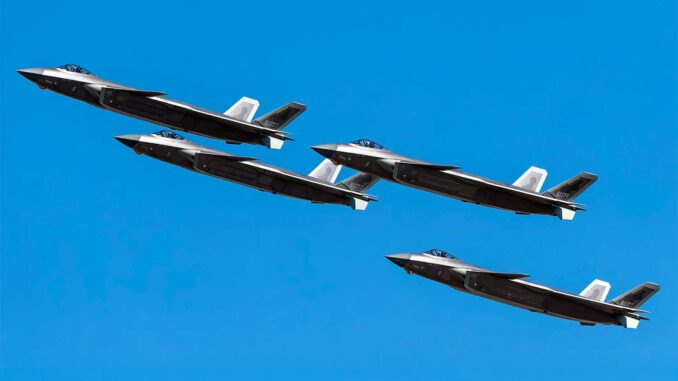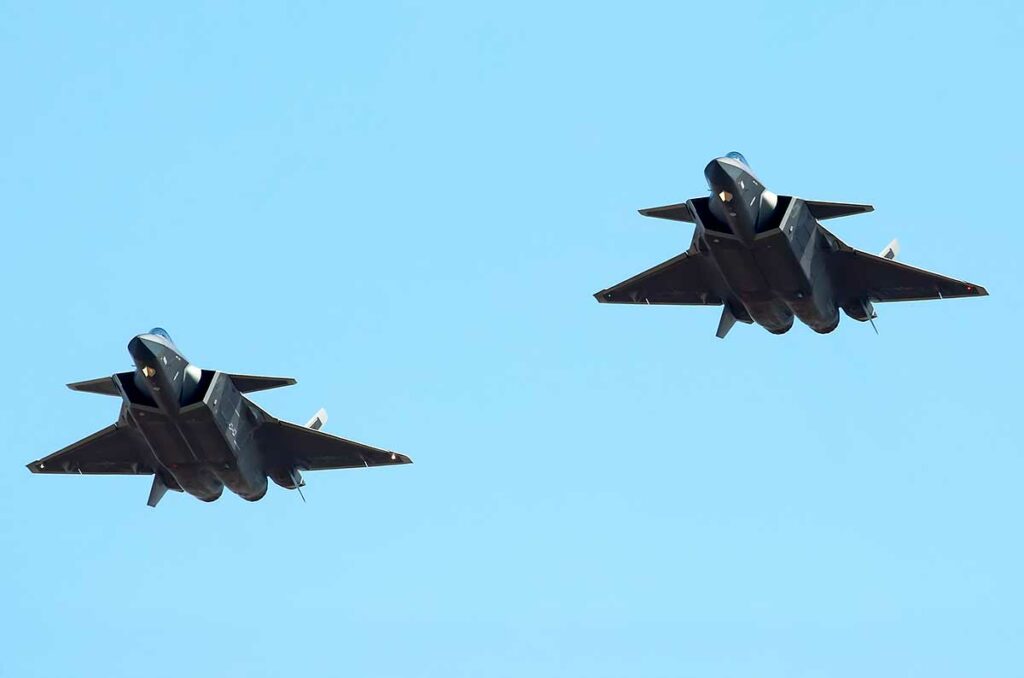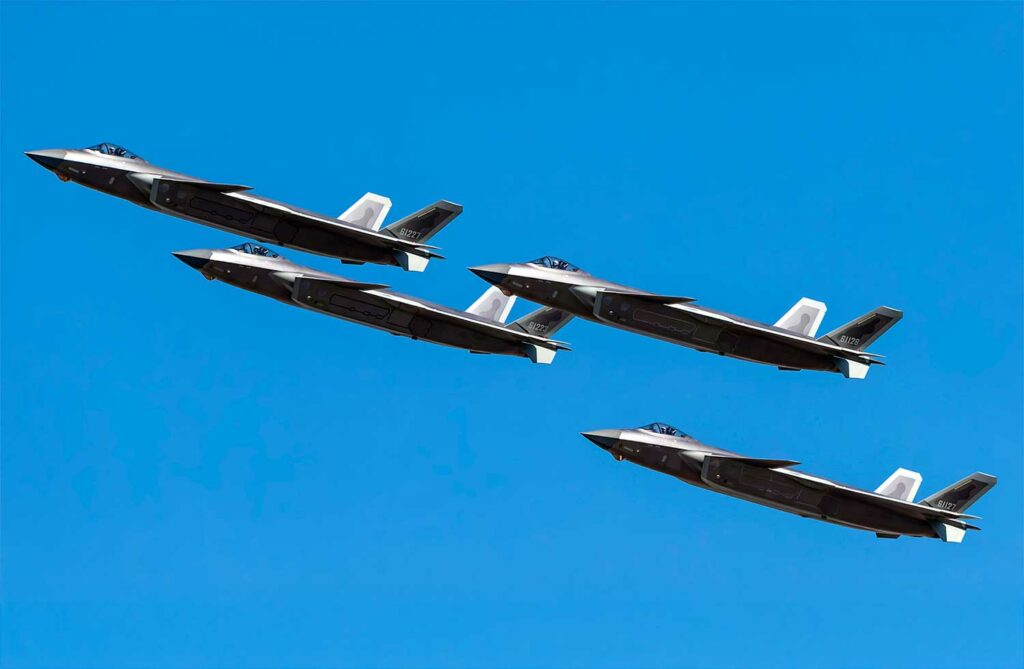
Is the J-20 capable of taking on NATO fighter jets in air-to-air combat? A technical analysis of its real capabilities against Western forces.
The J-20, developed by Chengdu Aircraft Corporation, is presented as the flagship of Chinese military aviation. Designed to rival Western stealth fighters such as the F-22 Raptor and F-35 Lightning II, it embodies Beijing’s ambition to achieve air superiority in the Asia-Pacific region and beyond. However, despite carefully controlled communication from the Chinese authorities, many questions remain about its air-to-air combat performance.
Is the J-20 really capable of threatening NATO aircraft in modern combat? This question goes beyond rhetoric. It touches on the actual capabilities of the detection system, engines, maneuverability, and weaponry. Every fighter pilot engaged in an air superiority mission must be able to rely on an aircraft with proven performance in complex environments saturated with electronic and kinetic threats.

An imposing airframe with partial stealth
The Chengdu J-20 is 20.4 meters long with a wingspan of 13.5 meters, similar in size to the F-22 (19 m long) but with a different aerodynamic configuration. Its wide fuselage and fixed side air intakes betray a structural compromise: stealth is not a priority across the entire spectrum.
Radar signature
Radar echo studies based on digital models estimate the radar cross section (RCS) of the J-20 to be between 0.1 and 1 m², compared to 0.001 to 0.01 m² for the F-22. This difference is significant: an AESA radar such as the AN/APG-77 on the F-22 or the CAPTOR-E on the Eurofighter could detect a J-20 at over 120 kilometers, compared to 70 to 90 kilometers for a F-22 under similar conditions.
The J-20’s partial stealth is partly due to its use of basic RAM coatings, which are less effective than those used by American standards. Its geometry still includes forward canards, which are useful for maneuvering but detrimental to electromagnetic stealth.
Infrared and passive detection
The J-20 is equipped with an IRST (infrared search and track) system, the EOTS-89, designed to detect enemy heat signatures. Although this system allows for radar-evading detection, it remains less effective than the DAS of the F-35 or the IRST21 of the F-15EX. In beyond visual range (BVR) combat, this difference in quality can be critical.
A still limited propulsion system
The J-20’s main Achilles’ heel remains its propulsion system. The first models were delivered with Russian Saturn AL-31F turbojet engines, which are not well suited to supersonic flight without afterburners (supercruise).
The WS-10C engine
Since 2021, some J-20s have been equipped with the WS-10C, a Chinese engine developing approximately 145 kN of thrust with afterburner. This engine provides reasonable thrust but does not allow the J-20 to maintain Mach 1.5 without afterburner, unlike the F-22, which can reach Mach 1.8 in supercruise.
The WS-15 program, which is supposed to reach 180 kN, is still struggling to get off the ground. In July 2024, tests revealed overheating problems at high altitudes. Without reliable propulsion, the J-20 is forced to limit its high-intensity mission profiles.
Mobility and thrust vectoring
The J-20 does not yet have a three-dimensional thrust vectoring system, unlike the F-22 or Su-35, which can direct their exhaust jets. This affects its ability to maneuver quickly in close combat (WVR).
For a fighter pilot, the lack of thrust vectoring means a dependence on initial speed and aircraft configuration, making it difficult to recover kinetic energy quickly.
Modern but improvable weaponry
The J-20 has an internal weapons bay capable of carrying six medium- and long-range air-to-air missiles. The main weapon is the PL-15, an active radar-guided missile with a ramjet engine.
Range and guidance
The PL-15 is credited with an estimated range of 250 to 300 kilometers, which is more than the European Meteor (200 km) or the American AIM-120D (160 to 180 km). However, this range is only achievable under optimal lock-on conditions and if the firing aircraft can maintain a secure data link.
Available data indicates that the PL-15 remains vulnerable to advanced electronic countermeasures (ECM). In addition, the J-20’s onboard radar, probably a local AESA version called KLJ-5, has not yet demonstrated reliable capability in high-speed multi-target engagement.
Close combat
The J-20 is reportedly still not equipped with an internal cannon. This absence reduces its close combat capability. The PL-10, a short-range infrared-guided missile, remains effective, but without a cannon, a pilot’s ability to handle a melee situation is limited.

A doctrine of use still under development
The effectiveness of a fighter aircraft also depends on its doctrine of use. The J-20 is currently deployed mainly in airspace close to mainland China.
Simulated engagements and deployment
The rare feedback from simulated combat exercises or real exercises against US aircraft such as the F-15 or F-16 indicates that the J-20 is used as a long-range interception platform, rather than as a multi-role fighter. It generally accompanies AWACS or operates under ground radar cover.
Communication and entry into service
Chinese military propaganda relies on highly controlled images. However, the J-20’s lack of participation in overseas exercises, such as Red Flag, or in engagements against credible adversaries, severely limits the credibility of its performance. The J-20 appears to be deployed more to assert regional deterrence capabilities than to compete with NATO in open theaters of operation.
Despite its modern appearance and advances in certain areas, the J-20 lags behind the latest NATO fighters. Its incomplete stealth, unreliable engine, lack of thrust vectoring, and weaponry still dependent on electronic effectiveness limit its capabilities in high-intensity air-to-air combat.
The aircraft represents progress for Chinese industry, but does not yet pose an equivalent threat to the F-22, F-35, or even a Rafale in joint combat. For a NATO fighter pilot, the J-20 should not be underestimated, but it does not redefine the balance of power. It remains a maturing aircraft, constrained by a cautious doctrine and a technological system that is still partially dependent on foreign technology.
War Wings Daily is an independant magazine.